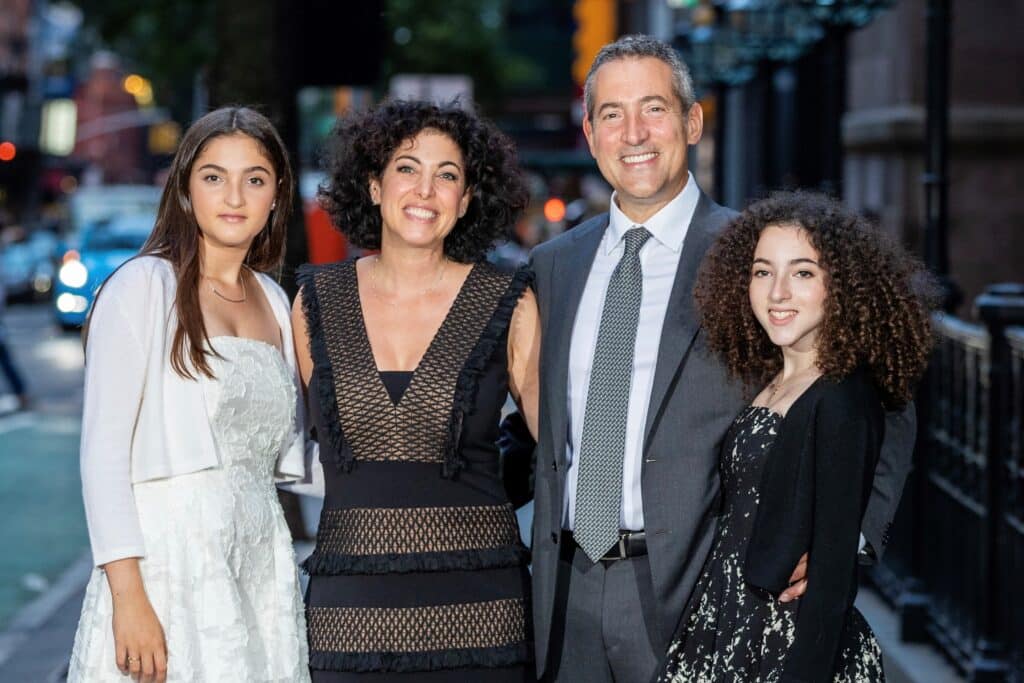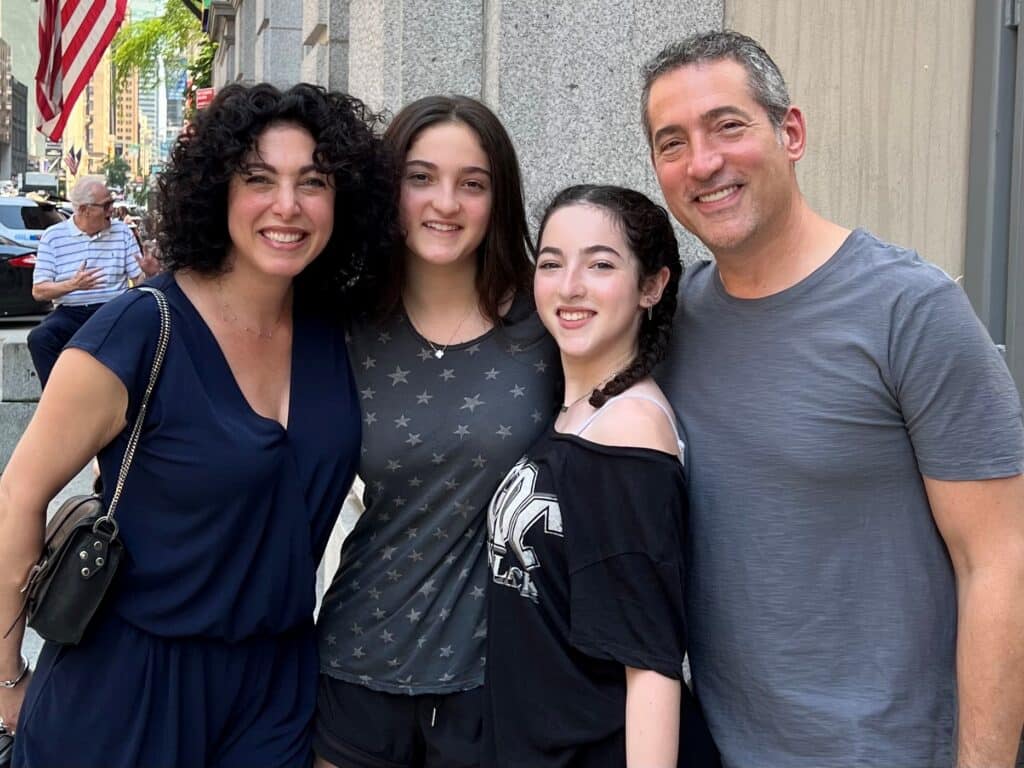Story of Hope: Scott Fink

Scott Fink is a born-and-bred New Yorker, married 20 years to his wife, Kelly, and father to 14-year-old twin daughters. He’s called New York City home for most of his life, aside from his undergraduate years at the University of Wisconsin-Madison and the early months of the pandemic when he moved his family to Long Island to shelter in place. Having worked at the American Stock Exchange on Sept. 11, 2001, he is no stranger to life’s challenges, but one of his biggest was being diagnosed with lymphoma in the midst of a raging global pandemic.
An avid runner, Fink has completed numerous half marathons. Following one of his training runs in October of 2020, he felt a debilitating pain in his back like nothing he’d experienced before. Unbeknownst to him, this was Fink’s first symptom, which ended up leading him to a lymphoma diagnosis.
“I would occasionally experience lower back soreness after a run, but this time I was having profound back spasms that were making me unable to walk,” recalls Fink. “It was New York, mid-pandemic, so I tried to manage the pain with Aleve to avoid going to the hospital. But eventually, we reluctantly called an ambulance to take me to the hospital.”
At the hospital, the ER doctors ordered an MRI, telling Fink it could be anything from meningitis to cancer. After failing to find anything conclusive and confirming that he was able to walk again, they sent him home with anti-inflammatory medication.
TRUSTING HIS BODY
While recovering, he decided to consult with his close friend (and brother of his brother-in-law), who is a neuroradiologist, about his condition. Fink shared the MRI images with him and continued to focus on recovering from his back pain, getting back to walking, albeit gingerly, around his apartment. A few days later, he received a call back with a recommendation that he follow up with his internist for more testing.
“He said, ‘Look, I’m obviously not sure and this isn’t a diagnosis, but this looks like it could be lymphoma’,” said Fink. “He’s a really heartfelt guy and was being as supportive as possible, saying that this was just his suspicion.”
The next day, Fink contacted his internist and shared the MRI images with her. Amid COVID, the internist wasn’t seeing patients regularly but asked Fink to come in to her office immediately. During his visit, the internist noticed some puffiness in Fink’s pelvic area and ordered a biopsy as well as CT and PET scans. Results revealed a mass close to Fink’s spine, a pelvic mass, and a mass in the pleural lining of his lungs. He was ultimately diagnosed with a subtype of non-Hodgkin lymphoma (NHL) called follicular lymphoma (FL).
Follicular lymphoma is typically a slow-growing or indolent form of non-Hodgkin lymphoma that arises from B-lymphocytes, making it a B-cell lymphoma. This lymphoma subtype accounts for 20%-30% of all NHL cases. Follicular lymphoma is usually not considered to be curable, instead categorized as more of a chronic disease. Patients can live for many years with this form of lymphoma.
Fink considered himself healthy, an active runner with no symptoms that would have made him suspect a lymphoma diagnosis. It turned out that the occasional back pain that he had experienced after running wasn’t just typical soreness from exercise, but instead was a mass that was getting dangerously close to penetrating his spine’s bone marrow.

“As far as I’m concerned, my brother-in-law’s brother saved my life. I was sent home from the hospital in the middle of a global pandemic with back spasms that they’d supposedly cured me of, and I would have just gone on with life, and the masses would have kept growing,” says Fink. “But he saw something, and he pushed me to take the steps I did. I tell him he’s my angel and I mean it.”
NAVIGATING TREATMENT AMID A GLOBAL PANDEMIC
Upon receiving his diagnosis, Fink’s mind went immediately to the worst-case scenario. Knowing nothing about the disease, he was uncertain what his future would hold or how he could overcome this obstacle.
“It was so unnerving for me. I was genuinely shocked, just blown away. I was afraid and initially had trouble wrapping my mind around what it was ultimately going to be,” said Fink.
Fink consulted with his oncologist on the next steps, not knowing what a course of treatment might look like. Approximately two months after his initial visit to the ER, Fink started the first of six rounds of treatment – chemotherapy and immunotherapy – every 21 days.
“I lived down the street from the hospital where I was being treated, so it was easy to get to, but I also was grateful that this hospital is dedicated to cancer and cutting-edge research,” said Fink. “My oncologist was also there, and I felt so fortunate to be in his care.”
“Most people who look like me don’t have those advantages. It’s great that I was able to find a new doctor and everything worked out, but not everyone has that,” says Ngon. “I think that’s where my voice is most needed in this space.”
Fink also felt incredibly thankful for his supportive network of family and friends. From his sister-in-law, who immediately stepped up to be his advocate during medical appointments, to his wife and teenage daughters, who engaged in important dialogue as a family throughout his treatment.

“My wife and I sat our daughters down and explained that it was going to be a rough few months, but that things were eventually going to be fine – this was just a bump in the road,” recalls Fink. “There was nothing I could do to shield them from reality, but we’re a really tight family and have great communication. We tried to just navigate everything as it came.”
Fink feels fortunate that his treatment was relatively routine, and in the new working world of virtual meetings, he could simply turn his camera off and continue to work.
“Consider everything we all went through during the pandemic. It’s mind-blowing to think that a global pandemic would be the secondary crisis in my family’s life during the last couple of years,” says Fink.
PROVIDING HOPE TO OTHERS
As of March 2021, Fink completed his treatment and is in remission. As he reflects on his lymphoma journey to date, he continues to be grateful for all the support and encouragement he received from his community – including the Lymphoma Research Foundation (LRF).
“One thing I learned early on in my treatment is that you shouldn’t internalize your feelings. Talking to people who have had similar journeys and letting yourself talk about it allows it to be a more livable situation for us all,” says Fink. “That’s the beauty of organizations such as LRF. Aside from the wonderful research they fund, LRF creates a community that ensures nobody feels alone.”
Fink recalls being approached by the husband of a fellow lymphoma patient when he was leaving one of his treatments. The husband was likely close to 80 years old and told Fink that his wife had been a patient of Fink’s oncologist for nearly 30 years. Someday, Fink hopes he can look back on 30 years post-treatment with the same positivity of survivors he has met along the way.
“I can only hope that anything I say or do gives someone else that same positive energy at a time when they need it most.”
Read More Articles from Pulse
Pulse is a publication of the Lymphoma Research Foundation, providing the latest updates on the Foundation and its focus on lymphoma and chronic lymphocytic leukemia (CLL) research, awareness, and education
